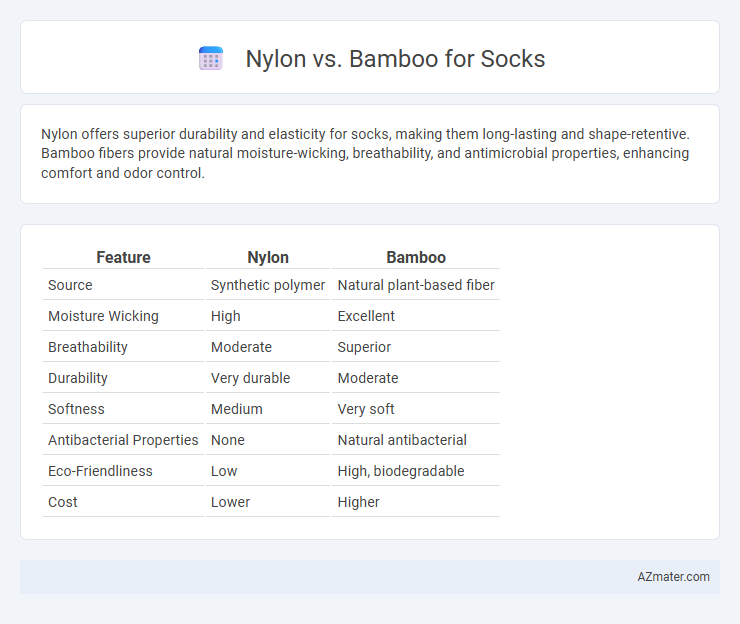Nylon offers superior durability and elasticity for socks, making them long-lasting and shape-retentive. Bamboo fibers provide natural moisture-wicking, breathability, and antimicrobial properties, enhancing comfort and odor control.
Table of Comparison
| Feature | Nylon | Bamboo |
|---|---|---|
| Source | Synthetic polymer | Natural plant-based fiber |
| Moisture Wicking | High | Excellent |
| Breathability | Moderate | Superior |
| Durability | Very durable | Moderate |
| Softness | Medium | Very soft |
| Antibacterial Properties | None | Natural antibacterial |
| Eco-Friendliness | Low | High, biodegradable |
| Cost | Lower | Higher |
Introduction to Nylon and Bamboo Socks
Nylon socks offer exceptional durability, moisture-wicking properties, and elasticity, making them ideal for athletic and everyday wear. Bamboo socks provide natural breathability, antimicrobial benefits, and eco-friendliness due to bamboo's sustainable growth and soft, hypoallergenic fibers. Both materials contribute to comfort and performance, with nylon excelling in strength and bamboo standing out for its environmental and skin-friendly attributes.
Key Material Differences: Nylon vs. Bamboo
Nylon socks offer superior durability, elasticity, and moisture-wicking properties, making them ideal for active wear and prolonged use. Bamboo socks provide natural antibacterial qualities, exceptional softness, and enhanced breathability, ideal for sensitive skin and eco-friendly preferences. The choice between nylon and bamboo hinges on prioritizing synthetic strength and stretch versus natural comfort and sustainability.
Comfort and Feel: Which Is Softer?
Bamboo socks typically offer superior softness compared to nylon, thanks to bamboo fibers' natural smoothness and moisture-wicking properties that enhance comfort. Nylon, while durable and elastic, tends to feel less soft and can sometimes cause a less breathable experience, making bamboo a preferred choice for sensitive skin. The natural breathability and hypoallergenic traits of bamboo also contribute to a gentler, more comfortable feel against the skin.
Breathability and Moisture Wicking
Bamboo fibers exhibit superior breathability compared to nylon, allowing better air circulation and keeping feet cooler during wear. Moisture-wicking properties of bamboo are highly efficient due to its natural ability to absorb and evaporate sweat, reducing odor and discomfort. Nylon, while durable and lightweight, generally traps more heat and moisture, making it less effective for moisture management in socks.
Durability and Longevity of Each Material
Nylon socks offer superior durability due to their high tensile strength and resistance to abrasion, making them ideal for long-term wear and frequent use. Bamboo socks, while softer and naturally antimicrobial, tend to have lower durability and may wear out faster under heavy use. Choosing nylon enhances sock longevity especially in high-stress activities, whereas bamboo provides comfort but requires gentle care to maintain its lifespan.
Odor Resistance: Bamboo or Nylon?
Bamboo fibers naturally contain antimicrobial properties that help reduce odor-causing bacteria, making bamboo socks highly effective at odor resistance. Nylon, while durable and moisture-wicking, lacks inherent antimicrobial qualities and may retain odor more easily over time. For superior odor control in socks, bamboo is typically the preferred material.
Sustainability and Environmental Impact
Nylon socks often rely on petrochemical sources, contributing to non-renewable resource depletion and slower biodegradability, whereas bamboo socks utilize rapidly renewable bamboo fibers that naturally resist pests and require fewer pesticides. Bamboo cultivation supports soil health and carbon sequestration, significantly reducing the environmental footprint compared to synthetic nylon production. Bamboo socks also offer biodegradable properties, making them a more sustainable choice for eco-conscious consumers seeking lower-impact footwear options.
Allergies and Skin Sensitivity
Nylon socks may cause irritation or allergic reactions in individuals with sensitive skin due to synthetic fibers and chemical treatments. Bamboo socks are naturally hypoallergenic and antimicrobial, making them suitable for people prone to allergies and skin sensitivities. Their moisture-wicking properties also reduce the risk of fungal infections and skin irritation.
Price Comparison: Nylon vs. Bamboo Socks
Nylon socks typically cost less due to the cheaper manufacturing process and widespread availability of synthetic fibers, making them a budget-friendly option for durable everyday wear. Bamboo socks, while priced higher, offer natural antibacterial properties and enhanced moisture-wicking, appealing to eco-conscious consumers willing to invest more in sustainable materials. Price differences range from 10% to 30%, influenced by brand, blend ratio, and production scale, with bamboo socks often positioned as a premium product.
Choosing the Best Sock Material for Your Needs
Nylon socks offer durability, moisture-wicking properties, and excellent elasticity, making them ideal for athletic activities and long-term wear. Bamboo socks provide natural antibacterial qualities, superior softness, and eco-friendly benefits, perfect for sensitive skin and sustainable choices. Select nylon for high-performance demands and bamboo for comfort and environmental sustainability.

Infographic: Nylon vs Bamboo for Sock
 azmater.com
azmater.com